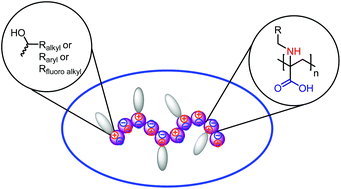Polyampholytic graft copolymers based on polydehydroalanine (PDha) – synthesis, solution behavior and application as dispersants for carbon nanotubes†
Abstract
We herein introduce a versatile platform of graft copolymers featuring a polyampholytic backbone and side chains of varying length and polarity using post-polymerization modification of polydehydroalanine (PDha). Nucleophilic substitution of the amino group with various modifiers in water allows the attachment of alkyl, fluoro alkyl, and aryl epoxides as well as a Michael acceptor (acrylonitrile), whereby the overall degree of functionalization (DoF) can be controlled by adjusting both concentration and reaction time. The synthesized graft copolymers were characterized by spectroscopic techniques (1H-NMR, 13C-NMR, solid state 13C-NMR, FT-IR), elemental analysis, and size exclusion chromatography (SEC) to prove successful grafting. By introduction of various side-chains, both the overall polarity and charge/charge density of the underlying PDha backbone changes, which is directly reflected in the solution behavior of the graft copolymers. We therefore investigated two examples by potentiometric titrations and ζ-potential measurements. As one example, modification with epoxyoctane led to amphiphilic graft copolymers which formed micelles in aqueous solution as revealed by dynamic light scattering (DLS) and transmission electron microscopy (TEM). Even more, we could show that these materials are promising dispersants for carbon nanomaterials (MWCNTs) and even pH-dependent reversible dispersion formation was possible. In general, the presented synthetic strategy opens up a wide range of novel surfactants with precisely tunable composition, polarity, and functionality.

- This article is part of the themed collection: Pioneering Investigators


 Please wait while we load your content...
Please wait while we load your content...